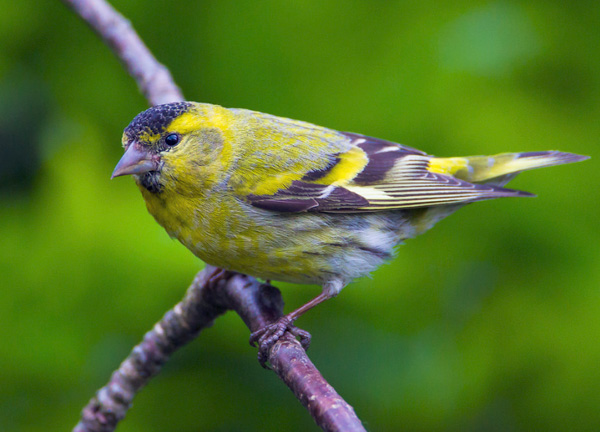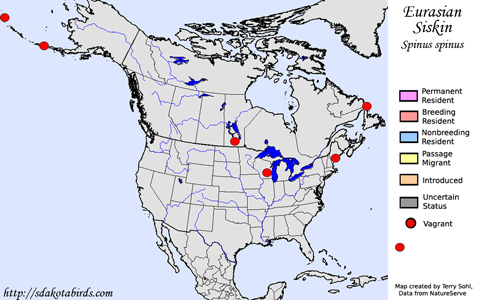| Length: 4.5 - 5 inches | Wingspan: 8-9 inches | Seasonality: Non-resident in South Dakota |
| ID Keys: Males greenish yellow overall, yellow breast grading to white belly, dark cap and chin patch, yellow and black wings and tail. Females similar but duller, and lacking black cap and chin. | ||
 The
Eurasian Siskin, also known as the European Siskin, Common Siskin, or simply
"Siskin" in much of its native range, is a small finch with a broad range
across Europe and Asia. The largest popoulation covers much of Europe,
eastward into western Russia and Asia. Another population is found in
far eastern Asia, including Japan. In North America, they are but rare
vagrants. Sightings accepted as those of true wild, vagrant birds by
the American Birding Association has occurred on multiple occasions in the
Aleutian Islands, on Atta and Unalaska. Other sightings with
unequivocal photo documentation have occurred in other parts of North
America, including Wisconsin, Maine, near Winnepeg in Canada, and
Newfoundland. Many birding groups consider the sightings outside of
the Aleutians to be escapees from captivity. Eurasian Siskins are
sometimes kept as cage birds in Europe, but that's simply not the case in
North America. The species also has been known to wander widely, and
there's nothing about the observations (leg banding, abnormal behavior for a
wild bird, etc.) outside of the Aleutians that would indicate a domestic
origin.
The
Eurasian Siskin, also known as the European Siskin, Common Siskin, or simply
"Siskin" in much of its native range, is a small finch with a broad range
across Europe and Asia. The largest popoulation covers much of Europe,
eastward into western Russia and Asia. Another population is found in
far eastern Asia, including Japan. In North America, they are but rare
vagrants. Sightings accepted as those of true wild, vagrant birds by
the American Birding Association has occurred on multiple occasions in the
Aleutian Islands, on Atta and Unalaska. Other sightings with
unequivocal photo documentation have occurred in other parts of North
America, including Wisconsin, Maine, near Winnepeg in Canada, and
Newfoundland. Many birding groups consider the sightings outside of
the Aleutians to be escapees from captivity. Eurasian Siskins are
sometimes kept as cage birds in Europe, but that's simply not the case in
North America. The species also has been known to wander widely, and
there's nothing about the observations (leg banding, abnormal behavior for a
wild bird, etc.) outside of the Aleutians that would indicate a domestic
origin.
Habitat: Found in a variety of conifer and mixed conifer/evergreen forests during breeding, but often found in and around areas of spruce trees. They will use a much wider variety of habitats in migration and in winter, including riparian areas, deciduous forests and woodlands, thickets and shrublands, and urban and suburban parks and gardens.
Diet: Feeds on seeds, often with a preference for spruce and pine seeds. They will also feed on the catkins and seeds from birches and alders, and other seeds. During the breeding season, insects and other small invertebrates are also taken.
Behavior: Quite active birds, they will use a variety of foraging techniques depending upon food source and location. They are often seen hanging upside down as they hold onto a pine or spruce cone, extracting and consuming seeds with their fine, pointed bill. They will also feed on the ground, or clamber through shrubs or tree canopies in search of food. They are very social birds outside of the breeding season, often found in flocks that not only include other Eurasian Siskins, but also sometimes other small passerines.
Nesting: The nest is built by the female, and is a cup of fine grasses, mosses, lichen, downy feathers, and other material that may be available. She lays 2 to 5 eggs, and she alone incubates the eggs, although the male will typically deliver food to the female during the incubation period. The eggs hatch after about 12 days. The young fledge from the nest about 2 weeks after hatching, but may stay in the vicinity and continue to be cared for by the parents for another week or two.
Song: A weak whistled CHURR-reee call is often given while in flight. The song is a longer serious of relatively quiet musical phrases, varying in pitch throughout and ending with a harsher rasp.
Migration: Across its broad geographic range, some Eurasian Siskins are semi-permanent residents. However, many populations, particularly those in the northern parts of their summer breeding range, are migratory and move southward for the winter. While not a true, seasonal migratory behavior, Eurasian Siskins are also nomads, often wandering in search of areas with strong spruce and pine seed crops.
Interactive eBird map: Click here to access an interactive eBird map of Eurasian Siskin sightings
Similar Species: Similar in size and structure to North America's Pine Siskins, and shares some of the similar wing and tail patterns. Overall though, Eurasian Siskins are much more brightly colored, with substantially more yellow tones on the body.
Conservation Status: Eurasian Siskins are found across a very broad geographic area, they are common in parts of their rane, and despite declines in overall numbers in recent decades, the overall population is still very high. The IUCN considers the Eurasian Siskin as species of "Least Concern".
Further Information: 1) BirdLife International - Eurasian Siskin
2) Oiseaux-birds.com - Eurasian Siskin
3) Beauty of Birds - Eurasian Siskin
Photo Information: Photo from "Natural England" - Photo licensed under Creative Commons Attribution NonCommercial NoDerivs 2.0 Generic License
| Click below for a higher-resolution map |
 |
| South Dakota Status: Non-resident in South Dakota |
Additional Eurasian Siskin Photos (coming soon!!)
